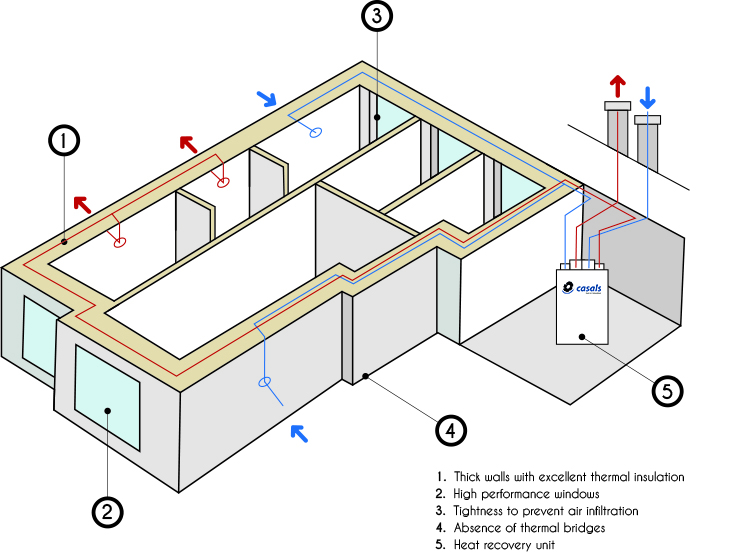Passivhaus is a voluntary energy certification standard for new construction and rehabilitated buildings. The goal is to achieve maximum comfort for the inhabitants of the house or building with good indoor air quality and practically zero energy consumption. A Passivhaus building offers energy savings of up to 90% compared to an existing conventional building, and 75% compared to new construction.
To achieve this certification, a holistic design process is necessary in which several factors intervene to achieve the certification and for the correct building operation.
In general terms, the basic principles of Passivhaus are 5:

Given the effects of global warming and the fact that we have hotter summers, the problem of overheating in buildings is becoming more evident, so strategies are established to avoid it. Thus, mainly in hot climates, other factors must be considered in addition to the previous list:
To obtain the certification it is necessary to justify that the risk of overheating in summer is eliminated, and it can be done in two ways:
In terms of ventilation, we will focus on the central axis of the Passivhaus certification: the airtightness test or “Blower door”.
An on-site test is carried out and the level of air infiltration is measured, through equipment that pressurizes or depressurizes the building. Before finishing the work with the interior finishes, preliminary tests are carried out to detect and correct leaks in time. Finally, the final test is carried out in accordance with the UNE-EN 13829 standard.
Reducing unwanted infiltrations has several advantages:
For airtightness to be possible, it will be necessary to install controlled mechanical ventilation that will ensure good indoor air quality and the evacuation of humidity and contaminants generated by the presence and activity of the people inside the building.
Efficient heat recovery is one of the fundamental principles for a building to function properly in accordance with Passivhaus.
A highly efficient heat recovery ventilation system can transfer more than 75 percent of perceived heat (sensible heat) from used exhaust air to fresh incoming supply air. On a 0°C Day, for example, these systems can make use of stale exhaust air, already heated to 20°C, to bring incoming cold air to at least 16°C without the use of active heating.
At the same time, in climates where cooling is necessary, the same principle applies: the energy recovery system keeps excess heat and humidity out while bringing in fresh air with appropriate humidity levels. In this case of hot and humid climates, the use of energy recovery units allows to effectively reduce the heat and humidity inside the building, in addition to the cooling needs.
In the Casals Ventilación catalogue you will find the ORMEN EEC residential heat recovery unit, with an electronic motor, suitable for floor and wall installation, which can serve residential and commercial premises with an area of up to 180 m2. The ORMEN EEC recovery unit has the Passivhaus Certificate.
The certification and audit begin in the project phase and ends with the end of the work. An entity approved by the Passivhaus Institute will be in charge of certifying that the project complies with the standard and that the work has been carried out as contemplated in the project.
The Passivhaus standard puts people's comfort first. For this reason, health and indoor air quality criteria are of great importance to the designer.
To guarantee good indoor air quality, it is checked that the air renewal system is properly dimensioned in the project phase. Once on site, the ventilation ducts are provisionally sealed, thus preventing the entry of dust. Once the work is finished, the start-up of the system and the measurement of flows in all the discharge and return mouths in accordance with the values of the project must be complied with.